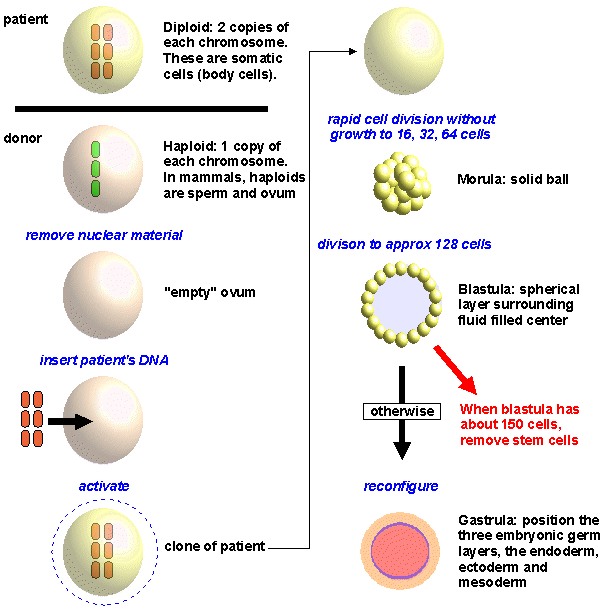Stem cell primer: What the Korean's did:
- Start with a haploid cell (an unfertilized egg)
- Remove the nuclear material
- Insert nuclear material from patient
- Activate the cell
- It begins to divide
- First to a morula
- Then to a blastula
It is at this point, the
blastula stage (about 100 - 200 cells), when
totipotent stem cells are extracted. Totipotent cells can grow into an entire organism and even produce extra-embryonic tissues.

A subsequent stage of growth, not reached in this process, is the
gastrula. Stem cells obtained at this stage are
pluripotent. Pluripotent stem cells cannot grow into a whole organism, but they are able to differentiate into cells derived from any of the three
germ layers. The mesoderm layer will form the muscles, many organs, connective tissue, and bones. The ectoderm layer will form the epidermis and nervous system, while the endoderm will produce the gastrointestinal tract, respiratory tract, and endocrine glands. Once gastrulation is complete, all germ layers are in the correct location and further growth and
organogenesis begins.
Organogenesis is a stage of animal development where the ectoderm, endoderm, and mesoderm develop into the internal organs of the organism. Vertebrates develop a neural crest that differentiates into the skull's bones and muscles and peripheral components of the nervous system.
Points:
- The process does not involve the destruction or manipulation of somebody else's fertilized egg (zygote).
- There is no conception taking place.
- The process involves creating a clone of the patient.
- Who owns that clone? It's the patient's DNA, and could be considered an extension of the patient, to be manipulated as the patient wishes. (Ignoring for the moment special cases of identical twins, where the DNA is also the same.)
- Some ethicists and religious figures are very concerned with the ethical implications of embryonic stem cell research. Some people believe that a human blastocyst is a human being with the same fundamental human rights. Some of these people thus oppose embryonic stem cell research because the start of each cell line involves the destruction of a blastocyst.
Why are we going through this process of examination? Because it wasn't clear from news reports exactly what was going on. What cells were used (unfertilized, and emptied-out ovum). At what point the patient's DNA is inserted (at the very beginning). And at what stage the stem cells are extracted (blastula).
This review is only that of the Korean project. There are additional reports of cell manipulation in Britain and Chicago - which are different in significant ways. But we thought it would be helpful to look at the Korean technique in order to establish certain points for discussion.
Our view?
At a minimum, that the patient owns (in effect) his or her cloned blastula, and can take stem cells out and work with them. Just like you can take your own skin cells and
grow them to replace scar tissue.
Cultured Epidermal Skin Grafts: The Physician may seek permission to take a small section of the patient's unburned skin to be used to grow skin in the laboratory for later use on the burn wound. The amount of skin taken will depend on the percentage of the burn, severity of the burn and the patient's condition. The procedure to obtain this skin is the same as harvseting unburned skin for skin grafts. The skin cells will grow rapidly so that in approximately three weeks it will be ready for transplanting.
Metaphysics angle: When the DNA is inserted into the emptied ovum, but not "activated", do religious conservatives consider a soul to be in existence? Or is it after the lab technician kicks the zygote so that is starts cell division?
posted by Quiddity at 5/25/2005 04:27:00 PM
Very interesting . . . I am no bio major but my sister (who is) tried to explain this to me . . . she didn't do as good a job as you.
I agree with hamstak, though. The fundies do not deal well with science, and fare even worse with uncertainty.
I have to say, I'm a little hesitant here, especially with the use of the term "clone." Perhaps it is scientifically accurate, but it does raise important ethical questions we should not take lightly, such as "what is a clone?" and "who owns it?" as you've pointed out. Let's not portray this as too blank-and-white; that's what righties do, and we're better (and more thoughtful) than that.
BTW, am I alone in not understanding some of the science here? I mean, I consider myself reasonably intelligent, and I have a BA (in the liberal arts, but nonetheless...), and I'm kinda lost.